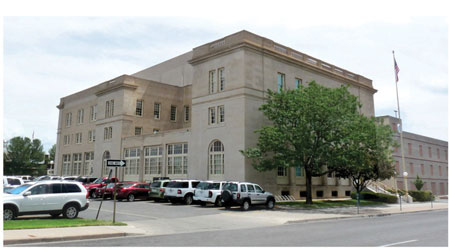GSA Commits to Historical Renovation, the Green Proving Ground, and Dedication to Occupant Wellness
Second of a three-part cover story showcasing the General Service Administration's sustainable success during the Obama Administration.
3. Old is new again
“We as an agency think historic preservation is inherently sustainable,” says Reed. “We’re always looking at how to reuse a building, always looking for ways to extend the useful life of buildings.”
The Aspinall Courthouse is certainly an example of this — it was constructed in 1918. But GSA’s portfolio includes hundreds of these pre-World War II buildings, and the amazing thing, says Reed, is that because of their greater thermal mass and use of daylight, they are often more energy efficient than ones that are only a few decades old.

(Built in 1918, the Aspinall Courthouse in Grand Junction, Colo., was renovated in 2013 with stimulus funds to be a net-zero energy building. The LEED Platinum facility includes a 128 kW photovoltaic system on its roof and a geothermal heat pump. Credit: GSA.)
The GSA’s Center for Historic Buildings is the office that provides leadership and technical resources on how to comply with the National Historic Preservation Act (1966). For instance, in the case of the Aspinall Courthouse, placing a photovoltaic array on a nearly century-old historical building meant making sure the panels were invisible from the street. As well, the array had to be an “additive structure” — meaning the array could be removed after 25 years or whenever its useful life is over (or if another is deemed more appropriate). Both of these requirements meant reducing the size of the originally designed system by about 35 percent. To compensate for the lost energy generation and to keep the building on track for its net-zero energy goals, designers added a geothermal system.
Reed says GSA’s strategy into the future is to continue to give funding priority to retrofitting and improving its owned stock of historic buildings. “We look at life-cycle costing, and we’re emphasizing decisions that bolster the long-term use of these assets,” she says.
4. Proof of green concept
The Green Proving Ground is an initiative that enables GSA “to make sound investment decisions in next generation building technologies.” Founded in 2011, the raison d’être of the Green Proving Ground is to test and show the viability of new and emerging technologies that can have maximum impact on buildings across the country. It’s essentially a “technology demonstration program,” says Reed.
For instance, a study published in September 2016 showed that a control optimization system for chiller plants could save 35 percent on energy. Because 80 percent of GSA’s floorspace is in large buildings, the majority of which is cooled by chillers, according to the report on this particular technology, implementing better control options for chillers can have a huge impact.
Another recent study showed a linear LED lighting system could save 27 to 29 percent on energy (with additional savings possible with advanced lighting controls) compared to a traditional fluorescent system.
GSA is careful to say that the Green Proving Ground doesn’t endorse a particular manufacturer’s products. Instead, it intends to provide proof of concept for green technologies it thinks can have the biggest impact both in its own facilities, but also in the private sector as well.
5. Fitwel-ness
Recognizing the high degree to which buildings affect human health, GSA continues to prioritize occupant health and wellness in its buildings – and passing on its knowledge to the private sector. To that end, it has collaborated with the Centers for Disease Control to develop Fitwel, a new evidence-based building rating system designed to measure impacts to occupant health and productivity. The rating system was introduced to 89 pilot buildings in 2016 and GSA and the Center for Active Design, which will administer the rating system, plan a full launch in 2017.
Fitwel uses seven “health impact categories” to address health and productivity. These include: Impacts community health, reduces morbidity and absenteeism, social equality for vulnerable populations, instills feelings of well-being, promotes occupant safety, increases physical activity, and provides healthy food options.
In November 2016, real estate investment trust Alexandria Real Estate Equities became the first organization to have facilities certified with the Fitwel rating system. As well, the architecture firm Perkins + Will has committed to be the first organization to certify all its facilities with the rating system.
GSA will continue emphasizing the health and well-being of its occupants with Fitwel specifically, but also with steps like providing information for its agencies on purchasing food at local farmer’s markets and providing lactation space and support, as required by 2010’s Patient Protection and Affordable Care Act.
Email comments and questions to greg.zimmerman@tradepress.com.
Related Topics:















